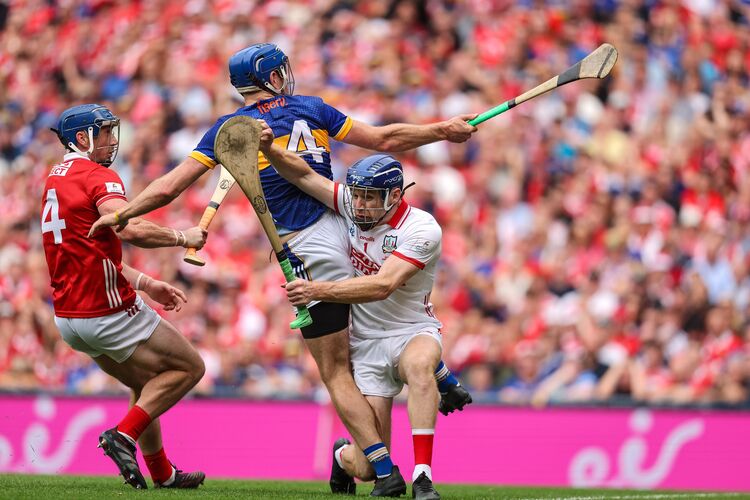[caption id="attachment_67210" align="aligncenter" width="600" caption="Assistant Commissioner Fintan Fanning, who led the Garda GAA Club trip to New York, makes a presentation to Ian McGowan, curator of "The Irish Whales: Olympic Champions of the NYPD, 1900-1924.""]
Sean Haran of Swinford, Co. Mayo, recognized a name when scanning the walls of the New York City Police Museum in Downtown Manhattan last Friday. It was Martin Sheridan, the Olympic discus thrower, shot putter, long jumper and high jumper who came from nearby Bohola.
"My grandfather used to talk about him all the time," he said. Haran added that his grandfather died nearing his 90th birthday about a decade ago, and he thought that Sheridan had had a long life too.
"No," said Ian McGowan, an expert on the subject. "In fact he died in 1918, the day before his 37th birthday."
Sheridan was one of the millions of victims of the flu pandemic sweeping the world at that time. The New York Times' obituary the next day said he was one of the greatest athletes that America had ever produced. Except of course, Sheridan wasn't American by birth. Like many of the early U.S. Olympic gold medalists, he was Irish and a member of the Irish-American Athletic Club based in Queens.
Much of this was new to the 52 traveling with the Garda GAA Club, Haran among them, who were in New York for the International Police GAA Tournament. McGowan, curator of "The Irish Whales: Olympic Champions of the NYPD, 1900 -1924," told them about Sheridan, Matt McGrath, from Nenagh, Co. Tipperary, Patrick Ryan, of Old Pallas, Co. Limerick, John Flanagan of Kilbreedy, Co. Limerick, and Patrick "Babe" McDonald from Doonbeg, Co. Clare.
He related how he'd been curious about the name of his apartment building in Queens and later discovered that Celtic Park was a holdover from the days of the Irish-American Athletic Club, which had its stadium on the site. He learned that the organization dominated U.S. track and field in the first quarter of the 20th century.
McGowan recounted how he stumbled upon a treasure trove of cups won by the club's athletes stored at the American Irish Historical Society's building on Fifth Avenue. Over the past few years, he has tracked down more trophies, including three on display in the exhibit that were presented at the Waldorf Astoria Hotel in 1908 following the London Olympics. In his campaign to document this chapter of hidden history, he had the support of NYPD Chief George Anderson and Sgt. Rich Wall, which paved the way for the comprehensive documentation of the club's history presented in "The Irish Whales."
McGowan told the visiting athletes, who were competing against GAA teams from the Police Service of Northern Ireland, the NYPD and the London Metropolitan Police, that while an athlete like Jim Thorpe from Oklahoma was very well known in this country, the remarkable stories of Irishmen of the same generation who won gold for America are not.
Ryan and Flanagan both settled back in Ireland. McGrath, who'd won silver in 1908 and gold in 1912, got another hammer-throwing silver at the 1924 Paris Olympics. He was 48, a record for the oldest American ever to win a track and field medal that still holds. Sheridan, in the years before his death, patrolled out of the downtown precinct that now houses the museum, while McDonald was for a time a beat cop at Times Square, where he became something of a tourist attraction.
"This would make a great movie," McGowan said.
"The Irish Whales: Olympic Champions of the NYPD, 1900 -1924" is showing daily through Oct. 30 at the New York City Police Museum, 100 Old Slip. It is presented by the Winged Fist Organization and NYPD Emerald Society. For more details about opening hours, visit www.nycpm.org.







